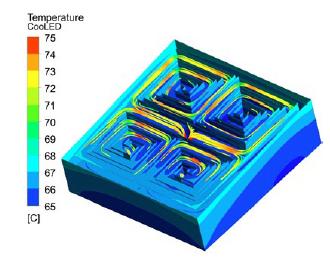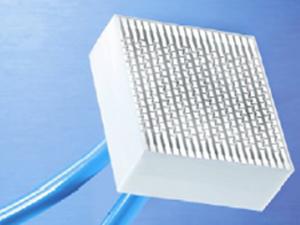Liquid-Cooled LED Arrays as Bright as 30 Headlights
March 27, 2012

Thanks to their increasing light output, high-power LEDs are becoming an interesting option for medical products, industrial image processing, and UV hardening, to name just a few.
Hundreds of very densely packed power LED chips are needed to illuminate large-surface objects. This can lead to thermal problems.
On top of that, high demands are placed on unchanging optical parameters, especially in UV applications, such as wavelength, chromaticity, forward voltage, and light output. Fluctuating temperatures or very inhomogeneous temperature distribution across the power module are unacceptable. A joint project sponsored by VDI/VDE-IT Bavaria faced these challenges and developed compact LED modules with a high packing density and output.
The Electronic Applications Division at CeramTec GmbH supplied innovative aluminium nitride (AlN) liquid-cooled heat sinks. The Fraunhofer IZM institute in Oberpfaffenhofen designed the thermal and fluidic cooling. The Fraunhofer IZM institute in Berlin populated the ceramic heat sinks with LEDs using new bonding techniques, and Excelitas Technologies GmbH & Co KG (formerly PerkinElmer Elcos) in Pfaffenhofen produced the functional LED module with an optical compound and electrical and fluidic interfaces.

The significant increase in output of the new cooling modules was made possible by several development projects. For example, the usual thermal bottleneck seen in glued components was avoided altogether through the development of new chip assembly techniques using optimized sintering processes for direct LED assembly on AlN ceramic heat sinks. The metalized Alunit ceramic creates efficient thermal coupling between the chip and the coolant.
Another area of emphasis was the development of a special thermal management system with even temperature distribution over the entire module that also takes other general conditions into account, such as scalability in every direction and simple handling. The CeramCool Box that resulted from this effort also allows quick adaptation of the illumination to the respective application requirements without any complex optics.
About the Author(s)
You May Also Like


.jpg?width=300&auto=webp&quality=80&disable=upscale)


